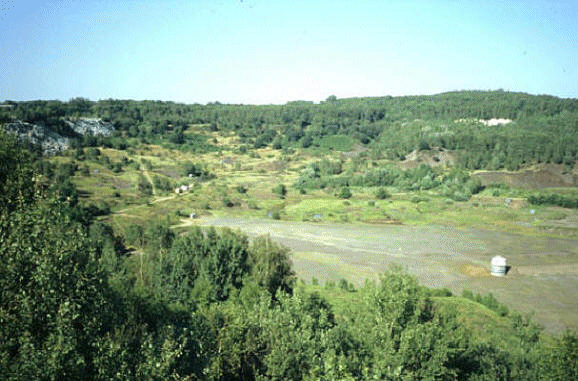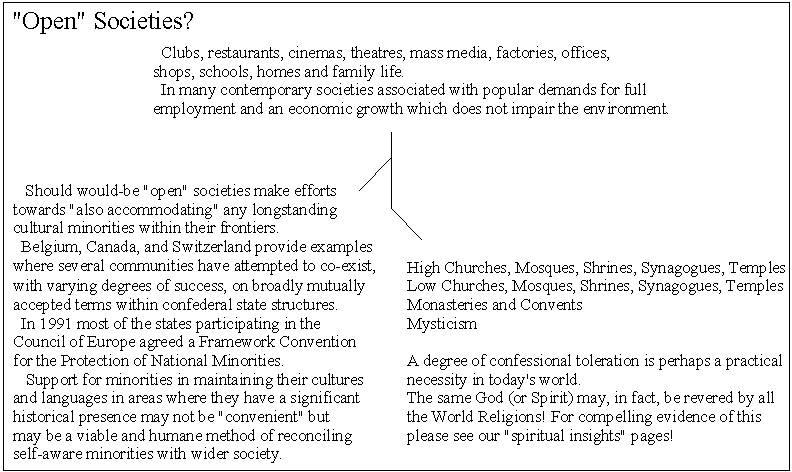Messel Shale Pit - Eocene fossils
World Heritage Site - Germany

The Messel Shale Pit, (a former quarry!), near Darmstadt, and
some 35 km southeast of Frankfurt am Main, Germany,
is widely famous for its regular yield of interesting fossils, (including those of a crocodile,
mini-horses, bats, a possible anteater and a tapir), - famous enough
to have been declared a World Heritage Site by UNESCO in December, 1995.
The extraordinary fossils found at the Messel Pit have been dated to the so-called
Eocene age which lasted from 54 million to 37.5 million years ago. The many millions of years of the Earth's
existence have been divided, for reference purposes, into
Eras, Periods and Ages, and in these terms the Eocene Age is part of the Tertiary Period and of the Cenozoic Era.
More interestingly, perhaps, the Greek derived word Eocene translates as "New Dawn" and palaeontology
recognises the Eocene as being the age of the first large land mammals.
The Messel Shale Pit seems to have been the site of a deep lake some 1.5km² in surface area
during the Eocene at which time the Earth's climate was warmer - furthermore it is also believed that since the
Eocene the - German - lands which now feature Messel, Darmstadt, and
Franfurt have "continentally drifted" all of 10o of latitude northwards.
The shales in the Messel Pit are oily shales probably as a result of heavy algal presence in a
lake then bounded by lush sub-tropical vegetation. Billions of
green algae called Tetraedron minimum would have lived their brief lives, expired, and join their billions of remains
to those many many billions already deposited further accumulating, along with muds, clays and rotting vegetation, a
bituminous deposit on the base of the lake.
The lake seems to have been within a volcanic crater and thus
replenished more by ground water and rain than potentially oxygen-bearing inflows from streams or rivers.
For much of the time, the surface layers of the lake were a hospitable place for fish, turtles, crocodiles, insects
and many other creatures to inhabit. The lower levels were however oxygen poor largely due to
the prodigious presence of dead Algae allowing the remains of
deceased animals to slowly fossilise through the assistance of bacteria
moulding or casting the tissues that would normally decay away
without being more radically disturbed by such
bioturbations as would otherwise have
resulted from scavenging by fish or other larger aquatic life.
The bodies of
any larger life forms that happened to expire into the
the lake would have been preserved for fossilisation
in the
anoxic conditions, or a marked lack of
oxygen, associated with the prodigious presence of decaying algae.
Apart from routine fatalities geologists also consider it possible that giant belchings forth of toxic volcanic gases perhaps released by
tectonic activity could, from time to
time, have also induced fatalities, as a result of gaseous poisonings or suffocations, of various species living near the lake, or flying over it,
whose remains would then become amazingly well preserved in the
anoxic bed of the lake.
During its years of service as a quarry many fossils were discovered, including the
famous early (1875) instance of a fossil crocodile, and found their way to museums
but by the 1960's other, artificial, materials competed for the market for tars and paraffin once claimed by materials
processed from the
Messel Pit.
![[view of messel pit fossils site]](messel_pit_fossils_site.jpg)
The quarry fell gradually into disuse at a time when its floor was already some 60m
below the adjacent lands. (The sedimentary formation has since been found to be more than 200 metres thick at the
center of the deposit, and this is held to represent
over one million years of accumulated deposition that principally took place some forty-eight million years ago in the
middle Eocene).
Believe it or not the Messel Pit almost ended up as a landfill for the dumping of waste!
It was formally proposed, in 1971, that
the then largely disused pit should be brought into service by local governing authorities as a "well managed" dump - the locals protested however -
even so an
approach road was constructed in preparation for the proposed new role.
Many fossils had been found during the decades the pit was mined for its tarry shales. The disuse of the site
was followed by organised attempts by local museum authorities to discourage amateur fossil collectors
accessing the site and digging fossils in the hope of making profits from their sale. Many, and truly amazing,
successes followed as special transfer-preparation methods were developed to protect the fossils from decay
in the fragile and readily disintegrating oil shale and preserve them permanently.
The Messel oil shale contains 40%+ water and exposure to air causes rapid drying and crumbling of the rock and of
the fossils contained therein.
It is necessary for specimens to be stored in cool, damp conditions and for
transfer to resin, (where the fossil is freed from the shale using needles and scrapers and
colourless, transparent resin is built up in thin layers), to take place promptly.
Given the state of preservation
evidenced
by many fossils that had been engulfed millions of years ago in oxygen-poor and bituminous deposits, the museums and other
academic fossil collectors became seriously interested and the proposed
development of the site as a dump began to become increasingly discredited.
In 1991 the Bundesland of Hessen bought the site for 35 million marks, and authorised the Senckenberg Museum,
Frankfurt, to co-ordinate further excavations.
An amnesty was declared in 1997 allowing fossils, collected irregularly previously to 1995, to be brought into the light of day,
and potentially into the interested attention of scientists.
When fifty-million-year-old vertebrate fossils are found elsewhere they are usually teeth and scraps of bone and
complete skeletons are great rarities. At the Messel Pit fossil quality is often of a very high order. The
anoxic conditions
resulted in the absence of "bioturbation" or vigourous feeding on the remains of deceased animals, birds, or fish, by anything more powerful or
disruptive than algae and bacteria.
Thus complete bony skeletons are available. Uniquely important however in the particular
fossilisation process is the apparent detail available of flesh, fur and feathers left as algae and bacteria fed on
organic materials but left outlines of what they had consumed - what ends up being fossilised is, in fact, the mineral
wastes excreted by bacteria that leave a detailed shadow in the shape of the soft parts they were devouring.
![[messel shale pit fossils]](leptictidium.jpg)
Fossil of Leptictidium (tr. graceful weasels), small,
warm-blooded, carnivores that moved around
kangaroo-style. Leptictidium were 60-90cm long
from nose to tail, weighing only two to four kilograms.
|
![[germany german fossil site]](amia_fossil.jpg)
Fossil of "Bowfin" taxonomic name:
Amia - Cyclurus kehreri
|
With some specimens, the bodies are surrounded by a so called Hautschatten ('skin shadow'). This dark area
preserves impressions of plumage on birds and
the individual hairs of mammals. The wing membranes and details of external ears are known from bats. Stomach
contents have also been fossilised in some cases allowing for detailed insight to be gained concerning the diet of
fossilised fish and mammals.
Example of a fossilised body with preserved soft
parts:-
A 50 million years old pygmy horse, with a shoulder height of 30 cm (or 12 inches),
from Messel (taxonomic name: Propalaeotherium parvulum)
with fossil stomach content (black) and preserved body outline (known as a skin shadow).
The detailed examination of the stomach contents showed that this particular "early horse"
ate the leaves
of deciduous trees and also ate fruit.
From May, 2009, the Messel Shale Pit and its fossils hit the headlines again with the announcement of
the discovery of the fossil a lemur-like, but also monkey-like, "intermediate" species from the Adapid family that
has been given the scientific name Darwinius
masillae and the nick-name Ida after the daughter of Dr. Jørn H. Hurum, one of the leading figures in the study of this fossil.
![[messel pit fossil site]](darwinius_masillae_messel_pit.gif)
The Ida - Darwinius masillae fossil
discovery from Messel Pit is that of a nearly complete
fossil of a young female "lemur-monkey" from the Adapid family allowing palaeontologists to gain important new
insights into the Adapids
and their place in evolution in relation to lemurs and to other primates.
Dr. Hurum, a palaeontologist at the University of Oslo, has described the
Messel Shale Pit site as:-
“one of the real treasure troves of palaeontology,
like the
Gobi Desert for dinosaurs.”
|
|
![[messel pit fossils site darwinius masillae ida]](evolution.gif)
![[messel pit fossils site darwinius masillae ida]](evolution.gif)
![[messel shale pit fossils]](leptictidium.jpg)
![[germany german fossil site]](amia_fossil.jpg)
![[messel pit fossil site]](darwinius_masillae_messel_pit.gif)
![]()
![]()

